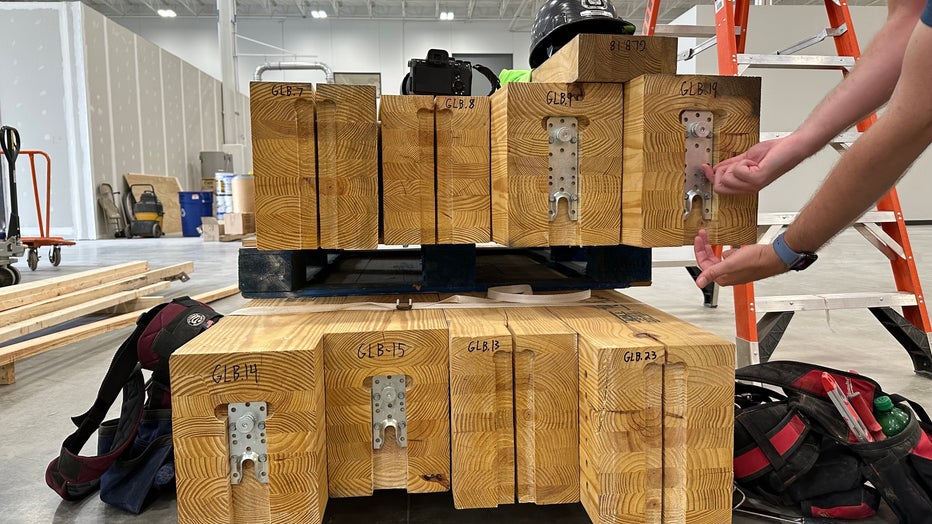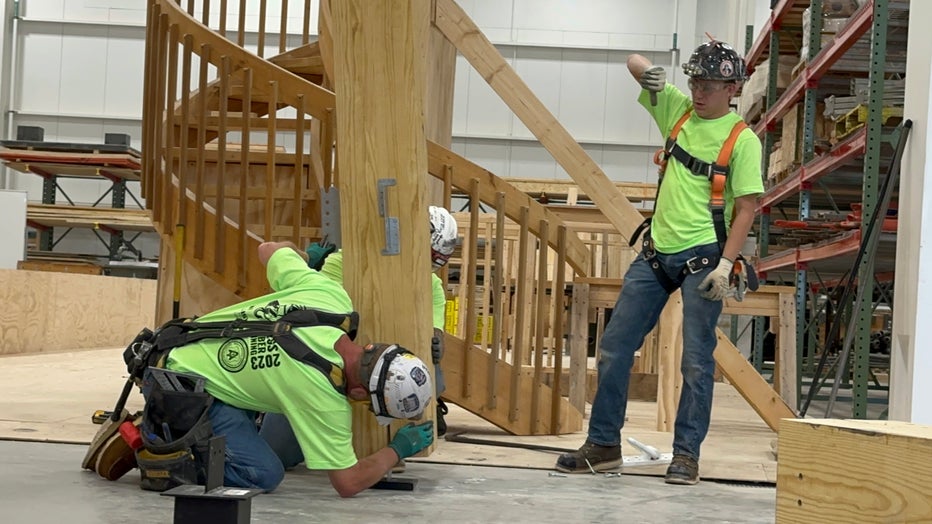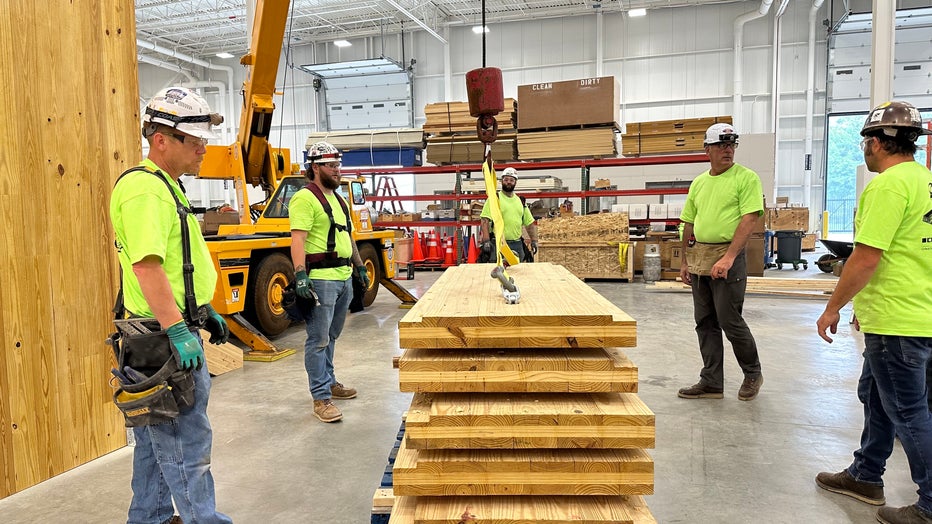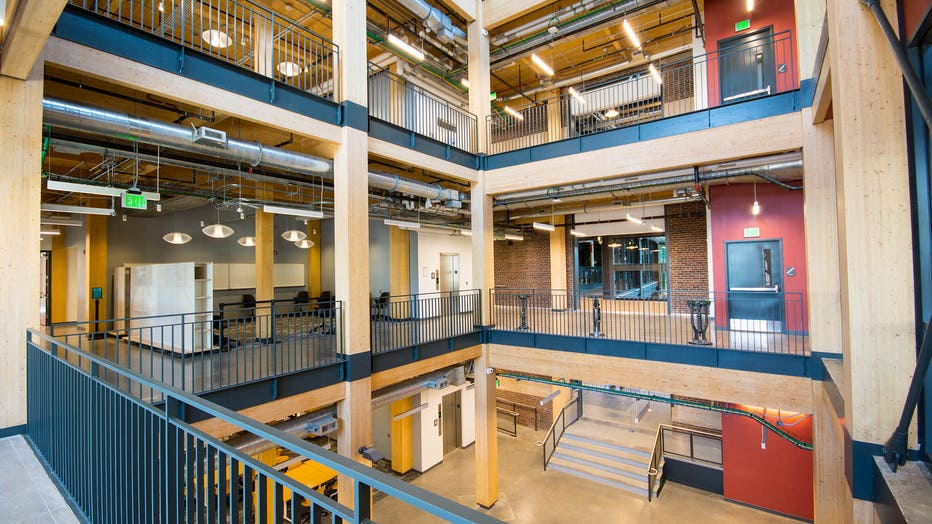Mass Timber's growing popularity in Michigan spurs training of carpenters to meet demand

Carpenters train building with Mass Timber
Specialized wood products are spurring a new style of building in Michigan. It's called Mass Timber and it's growing in popularity as a replacement for steel and concrete in structures.
DETROIT (FOX 2) - Inside the Millwright and Carpenter Union's massive training center in Detroit, a new building method is taking shape. It's a little like building with Lincoln Logs, except much bigger and capable of supporting the weight of an entire building.
The pieces come pre-cut and pre-drilled, ready to be assembled. All the workers have to do is follow the instructions. When put together right, the finished product will be a strong as steel and concrete - and much prettier to look at.
"The feel is just totally different," said Joe Decker, one of the carpenters learning how to build with mass timber at the training center.
Decker has been in the industry for 30 years. He spent the first half of his career in the display industry working at trade shows, including the Detroit Auto Show. Now at Christman Constructors, he's learning how the next generation of buildings will be built.
"It's different than your typical concrete and drywall. If you walked into a room that had this type of structure versus walking into a room with concrete, steel, and drywall, it's going to feel totally different," he said. "To me anyway."
In front of Decker is a team of carpenters with hard hats and light green shirts that have "Mass Timber Training 2023" on their backs. There are also pillars of wood and a crane to lift them up. The task before the builders is to configure the pieces into a basic wooden home that stands a couple of feet off the ground. The only metal are the anchors bolted to the ground and brackets waiting to be fastened.
Wood is making a comeback as a building material both in the U.S. and in Michigan - though not in its traditional form. The new category of wood building, called mass timber, consists of multiple panels of wood that have been glued or nailed together. The alternating direction of the wood pieces gives it strength that can support apartment buildings and training centers.
"It's a very humble material you're building out of - like we've done for literally hundreds of years," said Steve Purchase, who works for the union. "But the technology has changed and now we can make this material useful again."

One reason mass timber is unique is the pieces that support the structure aren't concealed from view. Instead, they are exposed, unlike the steel beams in traditional buildings.
And it's being made useful in Michigan, which is witnessing several mass timber projects being built. Hoping to catch the industry as it ramps up, the state's carpenters and millwrights union is training its members how to build with mass timber.
Christman Constructors has been a part of multiple mass timber projects in 2023. Since its employees are already familiar with operating a construction site, their bosses aren't worried about them mastering the new method.
"These guys are carpenters, so this is easy," said Foreman Mike Wisusik.
"It's just lifting and drilling"
Inside the union's Detroit office, located off the Lodge freeway, it's day 2 for the trainees. Midway through, they are about to attach a wooden beam to the top of a structure when they're stopped by the foreman.
Wisusik asks the workers how they're going to put the floor pieces in if they've already built the roof. "They were going to set that last beam in place. That would create a problem though in getting the floor pieces with the crane into place."
Since mass timber materials arrive at a job site ready for assembly, carpenters will need to worry less about if the pieces fit and more about when to attach them.
"On a real job site, that sequencing is maybe a little bit more clear because you're not putting the columns up on the next floor until the deck is on the lower floor," said Wisusik.

Mass Timber pieces arrive at the construction site with pilot holes, pre-cut grooves, and metal brackets already attached, making assembly quicker and shortening the building process.
It's a teachable moment for the trainees, who are still learning about the inverted building process.
The construction follows a different order that traditional projects, but it also simplifies it. And for carpenters and millwrights already familiar with a construction, "it's just lifting and drilling," Wisusik said.
Training to build with mass timber spanned three days in late June at the union's Detroit office. After morning lectures, the carpenters got to work on a practice home. The previous day, they spent time putting up the three walls of the structure. By the end of the second day, they'll be done.
On Day 3, they'll disassemble it for the next class.

Floor pieces made up of three panels of wood adhered together. Their alternating direction increases its strength.
Class started with screwing brackets into the wooden frame and anchors to the ground. From there, 15 foot-tall columns are lifted by a crane and set down on anchors. It takes a little wiggling, but eventually the groove already cut into the bottom finds the anchor on the ground and is snuggly attached.
MORE: Why are buildings getting bigger in Southeast Michigan?
Next the crane lifts two shorter wooden beams that will attach the column to the wooden structure. It takes a little finessing from the trainees, lining up the pieces before hammering them with a mallet and securing them with screws.
On the other side, floor panels heading for the wooden structure's interior are lifted by a crane. After those are installed, the next piece that moves in is the roof.
Mass timber momentum
Steve Purchase calls mass timber a great irony.
Steel and concrete have been dominant materials in the building industry in part because they're resistant to fire. Historically, wooden constructions have often fueled massive blazes in cities like Chicago, making a shift toward less flammable materials a must.
The irony isn't just that the building industry is shifting back toward wood, but the wood being used is more resistant than steel to high temperatures. If a fire were to erupt inside a mass timber building, the columns holding up the building wouldn't break.
The fire would char the outer layer of the pillar, while the inner layer would be untouched, Purchase said.
"Mass timber structures are designed so that you don't need the entire width of this column for structural support," he said. "If char forms, it's no longer combustible and eventually the fire will burn itself out."
Another unique feature of mass timber is those columns don't just hold up the building, but make it look good too. Traditional buildings made with concrete and steel conceal the load-bearing portions of the structure. Mass timber shows them off.

Inside the Michigan State University STEM Teaching and Learning Facility, the largest, and one of the first, mass timber buildings in Michigan.
That change in materials could have major implications for the building industry. It means fewer fossil fuels being burned to create steel and concrete. It simplifies the building process, which shortens the time that a construction site is active.
"When you do that, you're taking carbon out of the long-term carbon cycle, so that's terrific," Purchase said. "It's like the only construction material that would show up on a job site carbon negative."
And developers are starting to take notice.
"We're seeing demand for mass timber like crazy," said Sandra Lupien, Director of MassTimber@MSU, a program that works to advance the industry in Michigan and the rest of the Great Lakes.
There are currently at least five mass timber structures made with mass timber in Michigan. Lupien is also tracking about three dozen other projects that are certain to or likely to use mass timber. They include multifamily dwellings, veterinarian offices, schools, and government offices.
"(Developers) really see the value in it," she said. "From a building owner and developer perspective, the natural wood is pretty and very aesthetic. When a developer creates mass timber buildings and sell it, they're likely to get higher prices for since it has more value to future occupants."
The largest mass timber building in the state is the MSU STEM Teaching and Learning Facility, which recently won awards for its design. The school is also working with the Department of Natural Resources on a supply chain analysis and demand survey to better gauge interest for the building style and how it can better accommodate the industry.
And state investment doesn't stop there. It recently sent representatives to Finland on a trade mission with a focus on wood building construction.

